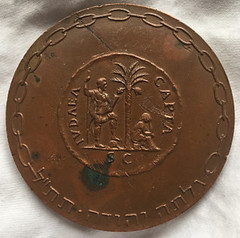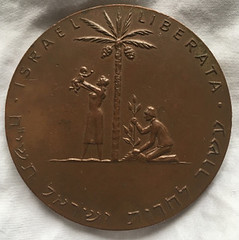
PREV ARTICLE
NEXT ARTICLE
FULL ISSUE
PREV FULL ISSUE
THE 1958 JUDAEA LIBERATA MEDALHelen Wang of the British Museum Department of Coins and Medals suggested this new blog article by Llewelyn Morgan of Brasenose College, Oxford. Thanks! Here's an excerpt.
-Editor
  This is not a coin but a copper medal, issued in Israel in 1958. On one side it reproduces a Roman coin in its centre, a brass sestertius from AD 71-2 in the reign of the emperor Vespasian (there’s a good image of an original coin here), and in fact the image on the medal closely reflects the size, as well as the design, of the original coin. Depicted on the Roman coin are the emperor, on the left, leaning on a spear, cradling a short sword in his other hand, and with his foot on a defeated enemy’s helmet. On the right is a woman in mourning, her head in her hand, seated on something generally identified as a cuirass. The scene is dissected by a palm tree, and bracketed by the Latin words IUDAEA CAPTA, “Judaea having-been-captured.” Judaea, corresponding roughly to modern Israel, was in antiquity renowned for its palm trees (Pliny, Historia Naturalis 13.26), which could thus symbolize the country. (The SC in the exergue below stands for SENATUS CONSULTO, “by the decree of the Senate,” its import disputed, but perhaps indicating that the coin was “the official Roman coinage”, to be distinguished from local coinages in the provinces.) This Roman coin, along with a large number of similar designs, celebrated the defeat of the First Jewish Revolt against Roman control of Judaea, which ended with Vespasian’s capture of Jerusalem in AD 70 and his destruction of the Second Temple. The loss of the Temple is marked by Jews as a key moment in their dispersal from their homeland. From the point of view of Vespasian, this was evidence of the military prowess with which he had defeated the enemies of Rome: there is an authentically Roman callousness in that image of a mourning woman, embodiment of the defeated people. Fully 8% of the coins minted by the Flavian emperors, Vespasian and his sons Titus and Domitian, addressed this campaign in Judaea, and the Arch of Titus in Rome, completed under Domitian in AD 81-2, depicts in two reliefs on its inner walls scenes from the Triumph celebrated by Vespasian and his elder son Titus in AD 71. On the south side we see the spoils from the capture of the Temple on display in the triumphal procession. The modern Israeli medal frames the Roman coin in such a way as to express the opposite perspective. Chains around its edge draw out the consequences for the Jewish population of Judaea, enslaved or dispersed, and the Hebrew at the bottom reads (my informants tell me), “Judea went into exile.” The year 1958, when the medal was produced, was the tenth anniversary of the establishment of Israel. The other side of the medal is a powerful, subtle reversal of the symbolic language of the Roman coin appropriate to that anniversary. The same palm tree dissects the scene, and again divides a man and a woman. But the woman is standing this time, and the man crouched, and the woman holds up her baby, while the crouching man, her husband, plants an olive tree, symbol of the modern state of Israel. The new tree and the old tree bear the same relation to each other as Israel to ancient Judaea: Judea or New Judea was an option considered for the name of the new nation. But the baby and the olive sapling especially speak of a future denied the mourning woman on the Roman sestertius. Finally, the inscription, which uses Latin to answer the Latin of the Roman coin, ISRAEL LIBERATA, “Israel having-been-freed,” and in Hebrew (again, I am reliably informed) reads “Ten years for the freedom of Israel”, followed by a date in the Jewish calendar corresponding to 1958. Ancient coins are fascinating little survivals in themselves, replete with significance if studied expertly and carefully enough. (I am no numismatist, and just get glimpses.) But a whole new dimension of meaning is introduced when they become part of modern expressions of national identity, in Greece, Afghanistan or Israel. Great medal! -Editor
To read the complete article, see:
 Wayne Homren, Editor The Numismatic Bibliomania Society is a non-profit organization promoting numismatic literature. See our web site at coinbooks.org. To submit items for publication in The E-Sylum, write to the Editor at this address: whomren@gmail.com To subscribe go to: https://my.binhost.com/lists/listinfo/esylum All Rights Reserved. NBS Home Page Contact the NBS webmaster 
|